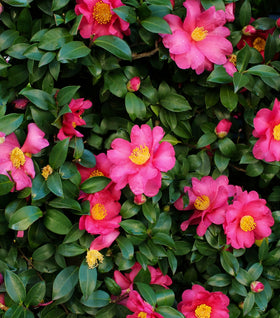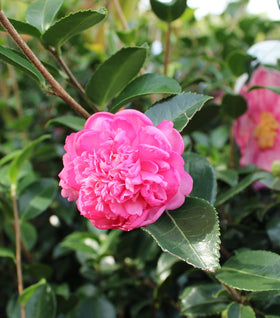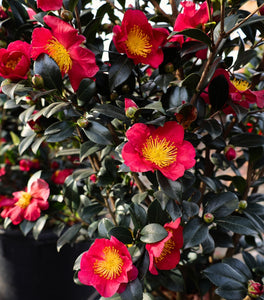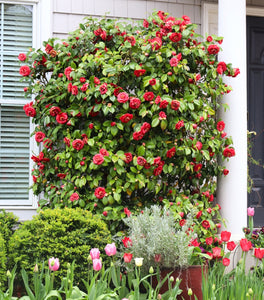Images Depict Mature Plants
Camellia Kanjiro Shrubs for Sale Online
Kanjiro Camellia is a stunning evergreen shrub that brings vibrant color and elegance to your garden during the colder months. Featuring an abundance of semi-double, deep, rosy-pink blooms, Kanjiro Camellia begins to flower in late fall and continues into early spring, providing a spectacular show when most other plants are dormant. Each bloom boasts a golden center that contrasts beautifully with the ruffled pink petals, adding visual interest to any landscape. Reaching a mature height of 6 to 10 feet and a spread of 6 to 8 feet, this camellia is ideal as a privacy screen, hedge, or eye-catching specimen plant.
Thriving in USDA Zones 7-9, Kanjiro Camellia prefers partial shade to protect it from intense afternoon sun and prevent leaf scorch. It flourishes in well-drained, slightly acidic soil that is enriched with organic matter, such as compost or peat moss, to ensure healthy growth and vibrant blooming. The dense, glossy dark green foliage remains attractive all year, making Kanjiro Camellia a reliable choice for adding evergreen structure to your garden. This camellia is versatile and can be used in various settings, including mixed borders, woodland gardens, or as an accent near patios or walkways, where its striking flowers can be enjoyed up close.
Caring for Kanjiro Camellia is relatively easy, requiring minimal maintenance to keep it looking its best. Light pruning after the flowering season helps to maintain its shape and promote better air circulation, while removing any dead or damaged branches ensures the overall health of the shrub. Mulching around the base helps retain moisture and protect the roots, especially during hot summer months. Fertilizing in early spring with an acid-loving fertilizer encourages robust growth and ensures a profusion of stunning blooms. With its captivating flowers, lush evergreen foliage, and easy care requirements, Kanjiro Camellia is a beautiful and rewarding addition to any landscape.
| Hardiness Zone: | 7-9 |
|---|---|
| Mature Height: | 8 to 10 feet |
| Mature Width: | 6 to 8 feet |
| Classification: | Broad Leaved evergreen shrub, Fall Flowering |
| Sunlight: | Full Sun to Part Shade |
| Habit: | Evergreen, densely branched |
| Flower Color: | Cerise Pink, semi-double |
| Foliage: | Dark green |
| Soil Condition: | Any well drained soil |
| Water Requirements: | Water well until established |
| Uses: | Extremely attractive when used as a focal point in the mixed border, mass planting, or a specimen planting. Provides unmatched winter interest due to its flowering in the early winter |
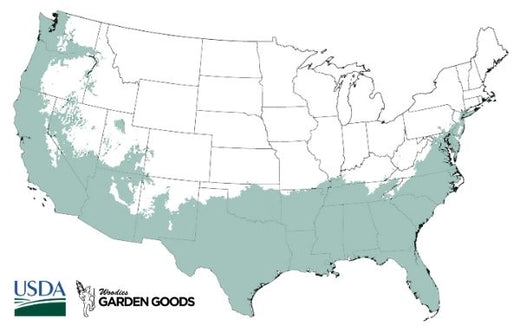
How to Care for Kanjiro Camellia
Be sure to read our planting instructions to ensure a healthy and happy Kanjiro Camellia for years to come!
How do I Plant Camellia Kanjiro Shrubs?
To plant Camellia Kanjiro shrubs, start by selecting a location that offers partial shade to protect the shrub from harsh afternoon sunlight, which can damage the leaves and blooms. The ideal soil for Camellia Kanjiro is well-drained and slightly acidic, enriched with organic matter such as compost or peat moss to provide the necessary nutrients for healthy growth. Begin by digging a hole that is twice as wide and the same depth as the root ball. This will allow the roots to spread comfortably. Place the camellia in the hole so that the top of the root ball is level with the surrounding soil. Backfill with a mixture of native soil and organic compost, gently firming it around the roots to eliminate air pockets. After planting, water thoroughly to help settle the roots, and apply a 2-3 inch layer of mulch to conserve moisture and keep the roots cool. Camellia Kanjiro is best planted in spring or fall when temperatures are mild, allowing the shrub to establish before facing extreme heat or cold. Space multiple shrubs about 6 to 8 feet apart to ensure enough room for their mature spread and to allow for proper airflow, which helps reduce the risk of disease. Regular watering during the first growing season is crucial to help establish a strong root system—keep the soil consistently moist, but not waterlogged. After establishment, the camellia will require less frequent watering but still benefits from consistent moisture, especially during dry periods. With the proper planting and care, Camellia Kanjiro will reward you with lush evergreen foliage and a profusion of vibrant rosy-pink blooms that brighten your garden from late fall through early spring.
How do I Water Camellia Kanjiro Shrubs?
Watering Camellia Kanjiro shrubs correctly is essential to ensure healthy growth, vibrant foliage, and an abundant display of blooms. During the first growing season, it's crucial to water deeply and consistently to help establish a robust root system—aim to water once or twice a week, depending on weather conditions. Make sure the soil remains consistently moist but not waterlogged, as Camellia Kanjiro is susceptible to root rot in poorly drained conditions. Deep watering encourages the roots to grow deeply, which in turn helps the plant become more resilient during dry spells. Use a soaker hose or drip irrigation system to deliver water directly to the root zone, which helps reduce evaporation and keeps the leaves dry. Once established, Camellia Kanjiro is moderately drought-tolerant but will still need regular watering during extended dry periods, especially when the plant is in bloom. Check the soil moisture regularly, and water whenever the top 2-3 inches of soil feel dry to the touch. During the hot summer months, maintain a layer of mulch around the base of the shrub to retain moisture, keep the roots cool, and reduce the frequency of watering. Mulching with organic materials like pine needles or bark also helps maintain the slightly acidic soil conditions that camellias prefer. With proper watering, Camellia Kanjiro will thrive, producing lush evergreen foliage and a stunning display of deep rosy-pink blooms from late fall through early spring.
How do I Fertilize Camellia Kanjiro Shrubs?
Fertilizing Camellia Kanjiro shrubs is key to promoting healthy growth, glossy foliage, and an abundance of stunning rosy-pink blooms. Begin fertilizing in early spring after the last frost to provide the nutrients necessary for new growth and bud development. Use a slow-release, acid-loving fertilizer specially formulated for camellias, azaleas, or rhododendrons, as Camellia Kanjiro thrives in slightly acidic soil. Apply the fertilizer evenly around the root zone, taking care to avoid direct contact with the trunk, which can lead to damage. After applying the fertilizer, water thoroughly to help distribute the nutrients and support root absorption. For continued health and vibrant blooms, consider applying a second round of fertilizer in early summer, but avoid feeding the shrub in late summer or fall, as this can encourage new growth that may be damaged by frost. Mulching with organic materials such as pine bark or pine needles will not only help maintain the soil's acidity but also retain moisture and keep the roots cool. If you notice any signs of nutrient deficiency, such as yellowing leaves or stunted growth, supplementing with additional organic matter like compost can provide a boost. Proper fertilization will ensure your Camellia Kanjiro thrives, producing beautiful flowers that enhance your garden from late fall through early spring.

How do I Prune Camellia Kanjiro Shrubs?
Pruning Camellia Kanjiro shrubs is important for maintaining their shape, encouraging healthy growth, and maximizing bloom production. The best time to prune Camellia Kanjiro is immediately after the blooming period, which typically ends in early spring. Pruning at this time prevents the removal of next season's flower buds, ensuring a vibrant display of rosy-pink blooms in late fall and winter. Start by removing any dead, damaged, or diseased branches, which will help improve the overall health of the shrub and prevent potential pest and disease problems. Thin out any crowded areas by cutting back crossing branches, as this will improve airflow and light penetration, allowing the camellia to thrive. To maintain the desired size and shape of Camellia Kanjiro, use light pruning to trim back overgrown or unruly branches, but avoid removing more than one-third of the shrub at any time, as heavy pruning can stress the plant and reduce flowering. If the camellia becomes too large or unshapely, rejuvenation pruning can be done gradually over a few years to bring it back into form. After pruning, apply an acid-loving fertilizer to support new growth and mulch around the base to conserve moisture and keep the roots cool. With regular and careful pruning, your Camellia Kanjiro will maintain its attractive form, producing healthy growth and an abundance of beautiful blooms year after year.









